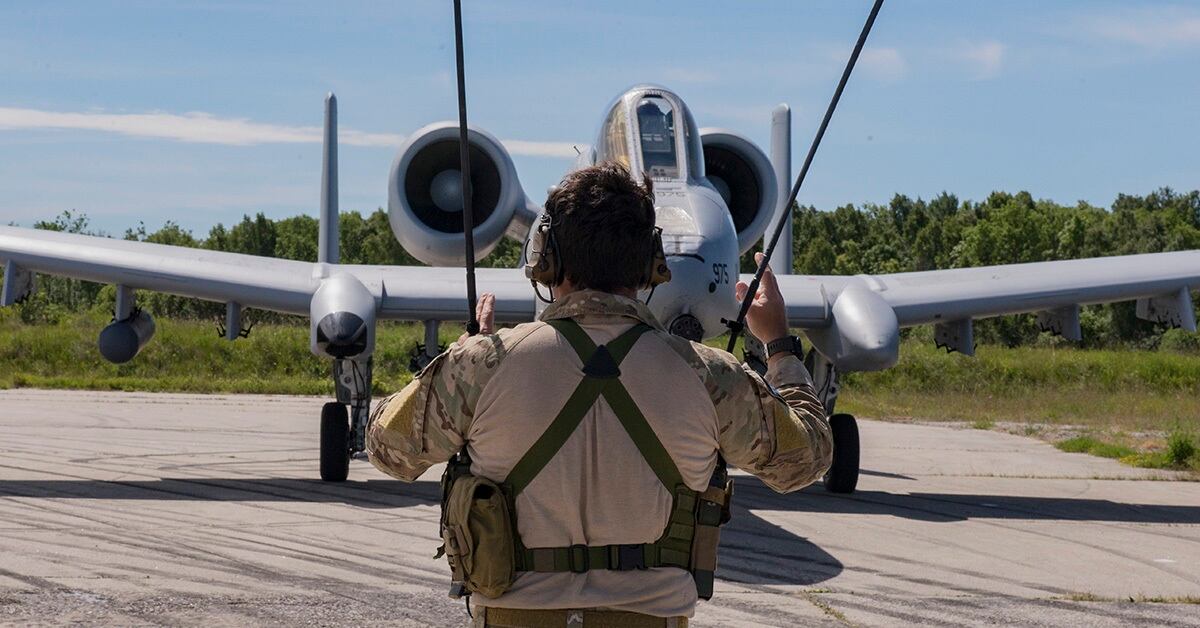The U.S. Air Force’s A-10 Thunderbolts and special tactics airmen have been practicing rough landings on improvised runways in the Baltic countries this month.
In early June, A-10s from the Michigan Air National Guard’s 107th Fighter Squadron and combat controllers from the 321st Special Tactics Squadron practiced landings and take-offs from rural highways and abandoned runways in Latvia and Estonia.
The airmen were training as part of Saber Strike 18, an annual NATO exercise designed to strengthen the alliance’s capabilities across Europe.
The practice of landing both airlift and close-air support platforms on improvised runways has been a long-standing capability in the Air Force’s arsenal. These rough landings give aircraft access to areas that lack conventional airports, Maj. David Dennis, director of operations for the 107th Fighter Squadron, said.

“The assumption is that the enemy is going to immediately destroy known airfields, so the A-10 has been tasked with being able to forward deploy into areas that are a little bit more austere — whether they’re known airfields, riverbeds [or] old highways,” Dennis said in a squadron video release.
Combat controllers from Air Force Special Tactics Squadrons can parachute onto the improvised airfields in advance of an aircraft’s arrival. From there, they direct air traffic, set up forward refueling points, and control airstrikes in support of friendly forces in the area.
Only recently, however, have A-10s returned in force to Europe for rough landing operations.
In June 2016, during that year’s Saber Strike exercise, A-10s landed on a highway in Estonia for the first time in 32 years. Then again, in August 2017, A-10s practiced on another Estonian highway in the north of the country. The training iterations are becoming a yearly necessity.
The A-10, with its wide, rugged tires and high ground clearance, is adept at these types of landings and takeoffs, Dennis said.

“The reason why the A-10 can do this ... is because it was designed to do this,” Dennis said. “Landing gear, all the way up to the high bypass engines that sit above the airplane, all of that is specifically designed so the airplane is not just survivable but can operate in this austere environment.”
In photos and videos of the event, the Air Force explained that the operations are designed to protect Estonia, Latvia and Lithuania — all members of the NATO alliance that collectively border Russia and close Russian ally Belarus.
Since Russia’s annexation of Ukraine’s Crimea peninsula in 2014, the Baltic states have feared a similar action against their own border regions.
“The region is of rising importance in the context of Europe’s changing security order,” NATO researchers wrote in a 2016 review of the alliance’s defense strategy.
Military exercises in the Baltic states, dubbed NATO’s “eastern flank,” are a key avenue through which deterrence and defense can be boosted.
“The number of major exercises conducted by NATO fully encompassing the land, sea and air power of its Allies in the Baltic Sea region should be increased,” NATO researchers wrote. “With Russia conducting ‘snap’ military exercises numbering 30,000-80,000 troops proximate to Baltic borders since the onset of the Ukraine crisis, the previous NATO exercises that have taken place in the region, such as the 6,000-strong Steadfast Jazz in November 2013, now seem rather modest.“
Kyle Rempfer was an editor and reporter who has covered combat operations, criminal cases, foreign military assistance and training accidents. Before entering journalism, Kyle served in U.S. Air Force Special Tactics and deployed in 2014 to Paktika Province, Afghanistan, and Baghdad, Iraq.









